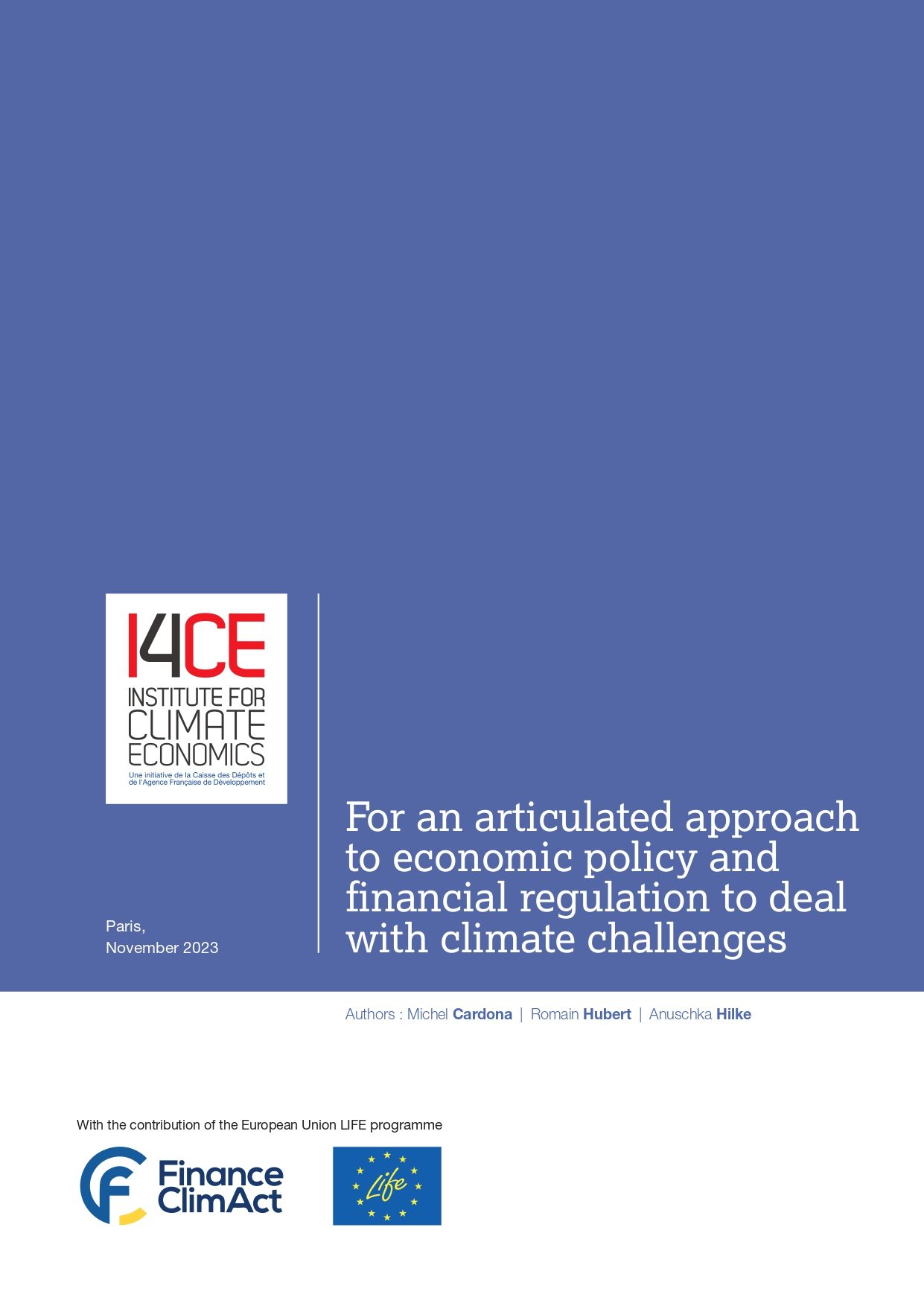For an articulated approach to economic policy and financial regulation to deal with climate challenges
The net-zero transition, i.e. the transformation towards a carbon-neutral and resilient economy, is a major and urgent challenge for reducing the effects of climate change. This transformation requires the transition and adaptation of all activities and all economic agents. It is first and foremost a matter for the real economy and must be based on an operational roadmap of actions to be taken. This must be defined by an ambitious economic policy (budgetary, fiscal, monetary, regulation of products and sectors, etc.).
What role should private finance play in this?
It must be a catalyst for transition and adaptation, not a brake on it. Whatever transition path is adopted, the scale of the financing and the depth of the reorientation of financial flows will be considerable.
Indeed, financing the net-zero transition requires not only financing activities that are already sustainable and “climate solutions”; it requires also to finance the transformation and adaptation of all economic sectors as well as stopping to finance the activities that emit the most greenhouse gases. It is therefore a crucial role that requires the transformation of the vast majority of the activities of private financial players alongside public financing.
However, it is illusory to think that private financial players will mobilise on a voluntary basis to meet the climate challenges. It is therefore essential for the public authorities to intervene proactively to mobilise them. The question is how.
Current policy to mobilise the private financial sector consists in adopting a silo approach:
- Economic instruments (budgetary, fiscal, regulatory) are used primarily to influence non-financial actors;
- Financial regulation (non-prudential) seeks to ensure the financing of the transition through market mechanisms;
- Prudential policy (banks and insurance) is aimed at preventing systemic risk.
The policy pursued by the European Union is a good illustration of this situation. It is not enough.
1) The silo approach is inconsistent with the close linkages between the economy and the financial sector
These linkages result mainly from two mechanisms that are also at work in the net-zero transition:
- the feedback loop between economic policy and financial sector stability: by ensuring an orderly transition and adaptation by economic agents, an effective economic policy can maintain the stability of the financial sector and thus avoids negative repercussions on public finances (which will not have to bear the cost of financial crises).
- Sufficient financing is essential for the proper functioning of the economy in general, and for a successful netzero transition in particular: yet this financing can be threatened by the instability of the financial sector, or by poorly calibrated financial regulations.
These linkages between the economy and the financial regulation mean it is essential to closely articulate economic policy and financial regulation.
2) The silo approach undermines the effectiveness of economic policy and financial regulation to mobilise financial actors in response to climate challenges
Three assumptions explain the prevalence of this approach:
- the preference of economists for using the price signal to encourage economic agents (businesses, households and financial actors) to make changes in order to reduce their GHG emissions;
- the confidence policy makers have in the efficiency of financial markets to finance the transition;
- the strong reluctance of supervisors (especially banking) to use prudential tools for purposes other than maintaining financial stability, particularly for promotional purposes (i.e. to redirect financial flows).
It is essential to go beyond the silo approach because it undermines the effectiveness of public action:
- economic policy based on a price signal faces major obstacles that reduce its effectiveness. Political and social factors have hindered the introduction of a carbon price signal at a sufficient level, and the effectiveness of the price signal itself is less than economists had anticipated;
- the increased transparency of financial markets is insufficient to mobilise the financial sector to finance the transition. It is slow and complex to implement. And fundamentally, it faces intrinsic obstacles; it seems illusory to think that voluntary initiatives will be sufficient to redirect private financing on a massive scale, given the prevalence of the risk/return trade‑off in decision making;
- the prudential approach adopted comes up against the radical uncertainty of climate risks (inherent in climate phenomena and in the transition itself). This radical uncertainty prevents the quantitative integration of climate risk into the prudential requirements of banks (pillar 1). The approach adopted (prioritising pillar 2, in particular through climate stress tests) also faces this obstacle and will not be sufficient in the face of systemic risk. A precautionary, preventive approach needs to be taken aiming at preventing the emergence of climate risks rather than guarding against their effect.
3) An articulated approach to economic policy and financial regulation is essential to finance the transition and to prevent systemic climate risk
Appropriate economic policy is an essential prerequisite that cannot be replaced by financial regulation. But, if such an economic policy exists and is sufficiently operational, the close articulation of economic policy and financial regulation (including prudential) can improve the effectiveness of public action.
Financial regulation could make the transmission of economic policy to financial actors more efficient
Indeed, it can:
- be rapidly mobilised;
- supplement an insufficient price signal with micro and macroprudential tools (e.g. capital requirements);
- use other transmission channels when the price signal is not effective enough (e.g. mandatory bank transition plans, or exposure limits);
- help overcome banks’ legacy problems due to the presence of potentially stranded assets (via capital or provisioning requirements).
An articulated approach would also enable prudential supervisors to better fulfil their financial stability objectives than the current prudential approach
Indeed, the prudential instruments used in the articulated approach to strengthen the effectiveness of economic policy vis-à-vis financial players also help to meet the objective of financial stability.
- The articulated approach consists in implementing a preventive approach aimed at facilitating the financing of the transition by encouraging a reallocation of financial flows. In this way, it takes into account the largely endogenous nature of climate risk (financial institutions contribute to climate change through the financing granted to emitting activities). Thus, by facilitating financing for the transition and adaptation, this approach would reduce climate risks and their impacts on financial actors; it would play a crucial part in preventing the systemic risks posed by climate change.
- The preventive, precautionary approach advocated above must do away with the exact measurement of risks by setting “conventional” prudential rules which depend on the desired impact on the reallocation of financial flows (and not based on an accurate evaluation of climate risks).
In the context of this articulated approach, economic and financial policies must be coordinated and coherent: adoption of common objectives and references, dynamic articulation of instruments over time, and use of complementary instruments to achieve objectives.
4) The implementation of this integrated approach will need to respect certain restrictions
- Avoiding conflicts of objectives between financing the transition and safeguarding the solvency of financial players, in particular by specialising the instruments used.
- Overcoming conflicts of time horizons between the prevention of medium‑to long‑term risks (through the reallocation of financing) and the emergence of shortterm risks that could result. In this context, it is essential to continue strengthening the individual supervision of financial players in the face of climate risks.
- Taking account of conflicts of intervention level (financial institution vs. financial sector), by combining micro- and macro-prudential instruments and strengthening the resilience of each actor.
- Resolving potential conflicts of mandate for financial supervisors to facilitate this articulated approach. The issue of the supervisors’ mandate will have to be carefully examined to assess the real benefits against the difficulties of such a change. But it is not clear that a change of mandate is essential to implement the proposed policy.
With the contribution of the European Union LIFE programme



